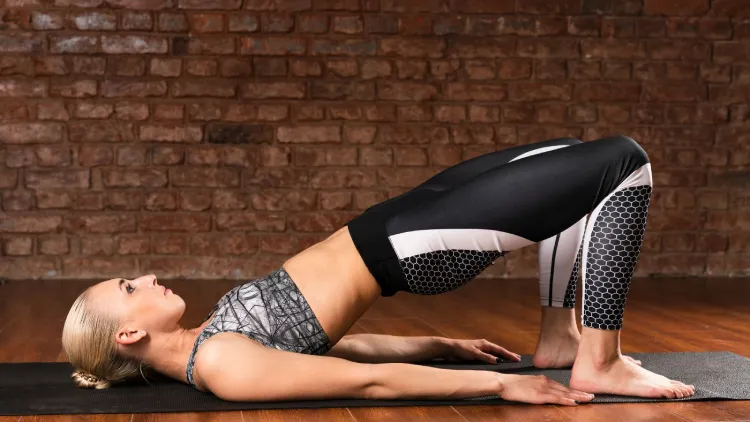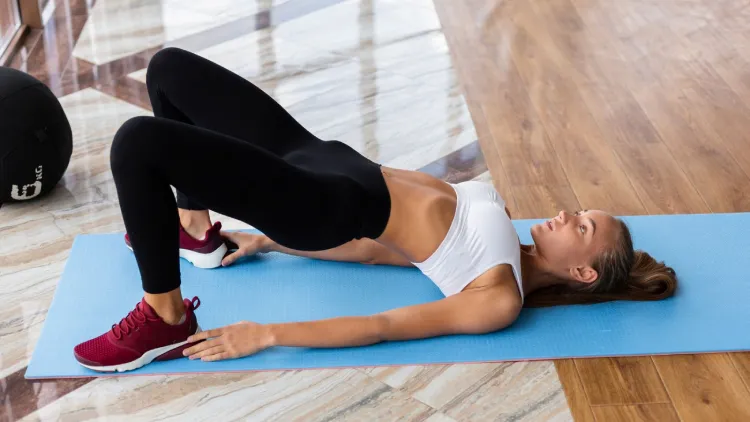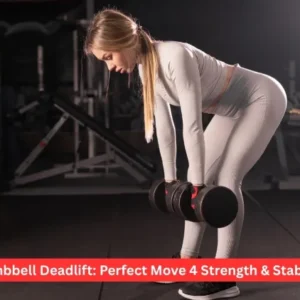Glute bridges are an effective lower body and core workout that is strengthening, toning and energising your glutes, as well as enhancing your posture, flexibility and balance. When done regularly, they may make your buttocks rounder, help improve your hips, help improve your athletic performance, and even help you shed the fat around your waist. It is an easy but useful exercise that could be done anywhere, with or without weight, and is indispensable in any strength or fitness program.
What Are Glute Bridges?
A glute bridge is one of the basic bodyweight exercises that involve the glute muscles, hamstrings and the core. It consists of rotating the hips off the ground in a supine position with the help of the glutes and the core to hold the body of the person. It is a perfect exercise among beginners and professionals since it is not very aggressive, yet very efficient in developing lower-body strength, stamina, and form.
The glute bridges mainly involve the gluteus maximus, which is the biggest muscle in your buttocks and is in charge of extending the hips and general strength in the lower part of the body. They also use the hamstrings, core and lower back, which assist in enhancing the posture and prevent pain or injuries related to the muscle imbalances. Since most individuals spend hours sitting, glute bridges will be a good option in re-engaging and training muscles that usually grow weak and dormant after some time.

Use of muscles in Glute Bridges
The glute bridges engage a number of important muscles that are crucial in movement, posture and stability.
- Gluteus Maximus: This is the major muscle that makes your hips extend and develop.
- Gluteus Medius and Minimus: Help to stabilise and side-to-side.
- Hamstrings: Assist in the motion and aid your hips in lifts.
- Core Muscles: Hold your torso straight, which is important so as not to overarch the spine.
- Lower Back: Moves the hips and holds them together.
- Hip Flexors: Get loosened, it increases the flexibility and decreases the tightness due to sitting.
This ensures that glute bridges are a great workout in terms of strength and flexibility to help in day-to-day activities, such as walking, using stairs, and lifting.
Glute Bridges: How to Do It Right.
Step-by-Step Guide:
- Lie on your back with your knees bent and your feet flat to the floor, and hip-width apart.
- Place your body with arms close beside the body and palms facing downwards to support you.
- Pull in your belly and squeeze your buttocks, and then get up.
- Push against your heels and push your hips up until your body is straight with your shoulders side by side and with your knees.
- Brachiate your buttocks and squeeze for 2-3 seconds.
- Slowly bring down your hips and do the same 10-15 times in 3-4 sets.
Hint: Have a tight core and do not bend your back. Your glutes and not your lower back or thighs should be the source of the power.

Benefits of Glute Bridges
The glute bridge has a remarkable list of rewards that will not just shape your butt:
- Tighter Glutes and Core: The exercise targets the glutes directly, to tighten, raise, and make your backend firmer and tighten the core.
- Better Posture: It strengthens the posterior chain, making the body straight, and eliminates its slouch.
- Less Lower Back Pain: The firm glutes can be used to alleviate the pressure on the lower back and stabilise the pelvis.
- Improved Athletic Performance: Improves the power of running, jumping and weight lifting.
- Improved Flexibility: The Flow of movements extends tight hip flexors, making muscles flexible.
- Fat Loss and Muscle Tone: Although glute bridges do not burn belly fat per se, they help to boost metabolism and muscle mass, which helps to burn fat.
- Reduced Waist: Use of glutes and core enhances the strength of the hip-skin, giving it a better hourglass appearance.
It takes approximately 4-8 weeks, depending on the intensity of your workouts and diet, before you can notice glute results.
Common Mistakes to Avoid
Although glute bridges are easy to perform, they can be more effective or cause an injury:
- Across the lower back: You should always call on your core to cushion your back.
- Employing momentum rather than the use of control: You should slowly raise and lower your hips to make use of all the muscles.
- Failure to squeeze the glutes on the top: A Strong squeeze is the essential factor of activation and development.
- Flexing forward instead of backwards: Push with your heels to get through with your glutes to their fullest potential.
- Improper position: Be sure that your knees, hips and shoulders are in line during the movement.
By correcting such mistakes, you will be sure that you are gaining strength effectively and safely.

Variations of Glute Bridges
These variations will provide some variety and challenge once you’ve mastered the basic form:
- Single-Leg Glute Bridge: Lift the leg and then the other to isolate each glute.
- Banded Glute Bridge: Place the resistance band around your knees to use the glute medius.
- Weighted Glute Bridge – To make this exercise more challenging, place a dumbbell (or barbell) on your hips.
- Marching Glute: Raise the knees one at a time, but keep the hips higher to improve stability.
- Elevated Glute Bridge: Use a bench or a step to raise your feet. This will increase the amount of movement.
These developments will be ideal in case you desire to make your glute bridges more vigorous or enhance muscle development in the long run.
Glute Bridges vs Hip Thrusts
The glute bridges are often confused with hip thrusts, although they are a little different. Both are directed at the glutes, but hip thrusts are usually done with the upper back leaning on a bench and regularly with weight added. The arrangement provides more space to move and increases loading capacity, which results in muscle growth at a faster rate.
Conversely, glute bridges are done on the floor and are more activation and endurance oriented as opposed to maximal strength. Both of them are helpful, although hip thrusts are more glute-building, whereas glute bridges are more beginner-friendly and can be used in everyday life.

Glute Bridges vs Squats
The two exercises are advantageous when it concerns glute development. Squats work several muscles at once, including the glutes, the quads, and the hamstrings, whereas the glutes can be focused on more with a glute bridge.
You would be better off using glute bridges and hip thrusts in case you want to build and shape your glutes in a particular way. Squats, however, are indomitable when it comes to general lower-body strength. A mixture of the two brings the two worlds together: power and form.
Daily Glute Bridges: Progression and Regression
Performing the glute bridges daily will help stimulate the muscles, decrease back pain, and improve posture. Nonetheless, your muscles require rest to develop bigger or stronger glutes. Doing them daily at a low intensity level is excellent in regards to mobility, though to build up muscle, seek 3-4 times a week with extra resistance.
Consistently done, glute bridges may strengthen your thighs, make your hips more shapely and create a more curvy and defined appearance of your body. They may also improve the circulation and make you more flexible, so they are not only useful in terms of aesthetics.
The drawbacks of Glute Bridges
Even though glute bridges are harmless and effective, they can have several constraints:
- Reduced load-bearing of hip thrusts.
- May cannot offer sufficient resistance to high-level lifters without weights.
- The wrong form may put a strain on the lower back.
- At stasis, one must stall results, or they will stall.
Even so, the disadvantages are minimal against the huge advantages when properly implemented.
Tips for Maximum Results
To maximise your glute bridge exercises:
- Concentrate on slow and controlled movements as opposed to speed.
- Weight lifting as strength increases.
- Have good mind-muscle coordination – practice the squeeze of the glutes.
- Add squats, hip thrusts and donkey knees.
Glute bridges should be combined with cardio and a high-protein diet to facilitate fat loss and build up muscles.

Conclusion
The glute bridge is not only one of the best exercises that you can perform to tighten and firm your glutes, but it is also the most convenient one, and there are many variations of the bridge. This move can work wonders on all individuals, no matter their intention of building muscle, having better posture, or just staying active.
Glute bridges allow you to develop stronger glutes, a stronger core, and a more engaged lower body. Not only does it assist with the lifting and tightening of your backside, it also assists in improving movement, sitting up and having confidence in general. And the transformation of your body in your butt is not only possible in a few weeks with consistent effort, but it all begins with learning to do this one straightforward, powerful movement.
Frequently Asked Questions
1. Do glute bridges work to build glutes?
The glute bridges can be very effective in strengthening and sculpting the glutes. When performed regularly, they target the gluteus maximus and lift, firm and tone your lower half.
2. Can I do glute Bridges every day?
To improve posture and activation, you can perform glute bridges every day at low intensity. For muscle growth, it is best to do them 3-4 days a week.
3. Do glute bridges reduce belly fat?
The main purpose of glute bridges is to tone and strengthen your glutes. They don’t burn belly fat directly, but they can help you lose weight by increasing your metabolism and building muscle.
4. What is the difference between hip thrusts and glute bridges?
Hip thrusts, which are done on a bench with added weights for more resistance and glute development, use Glute Bridges on the floor.







